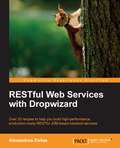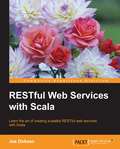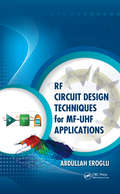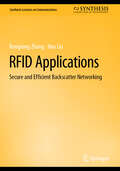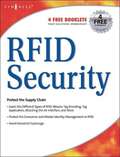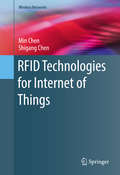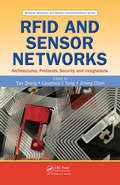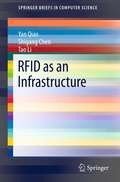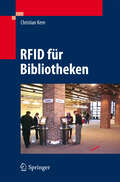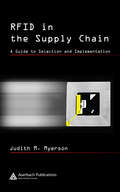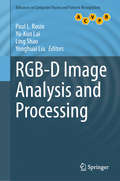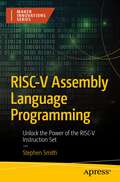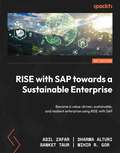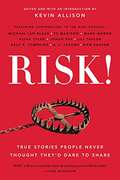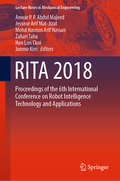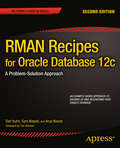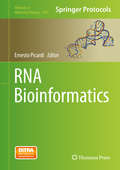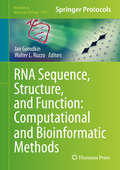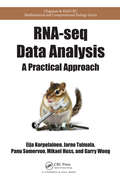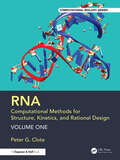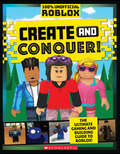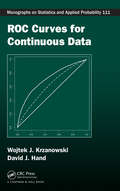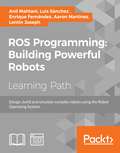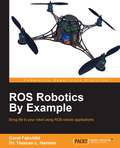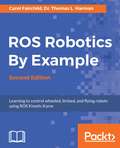- Table View
- List View
RESTful Web Services with Dropwizard
by Alexandros DallasA hands-on focused step-by-step tutorial to help you create Web Service applications using Dropwizard If you are a software engineer or a web developer and want to learn more about building your own Web Service application, then this is the book for you. Basic knowledge of Java and RESTful Web Service concepts is assumed and familiarity with SQL/MySQL and command-line scripting would be helpful.
RESTful Web Services with Scala
by Jos DirksenLearn the art of creating scalable RESTful web services with Scala About This Book * This is the only book on the market that will help you create scalable RESTful web services using five popular Scala-based REST frameworks * Quickly identify the best framework for a specific problem and select the most appropriate solution to suit your requirements * This practical guide will help you implement a complete REST-based API from scratch Who This Book Is For If you are a Scala developer with some Scala experience and you want to get an overview of the frameworks that are available in the Scala world, then this book is perfect for you. You need to have a general knowledge of REST and Scala. This book is great for senior Scala (or other language) developers who are looking for a good REST framework to use together with Scala. What You Will Learn * Set up a development environment to easily develop and test REST services * Discover the different ways in which you can create REST services with Scala * See and explore the different approaches taken by popular REST frameworks * Get to know more about a variety of available Scala frameworks such as Finch, Unfiltered, Scalatra, Akka-HTTP, and Play * Discover how to create a REST service on top of each framework discussed in this book * Create HTTP clients using the frameworks in this book * Make an informed decision about which framework to use in a specific situation * Set up authentication for your REST services In Detail RESTful web services are built to work best on the web. Scala provides a rich set of language constructs and advanced frameworks that you can use to create REST services. However, using Scala and these tools can be a complex task. There are many frameworks available and choosing the wrong framework or approach can cost a lot of time and lead to much frustration. By exploring the most popular Scala REST frameworks, you can make sure you choose the right tool. RESTful Web Services with Scala begins with a brief explanation of the REST architecture and its implementation in Scala, as well as the impact that REST architecture has on Scala applications. You will understand the advantages of building Scala web services and how existing Scala applications can take advantage of REST. This book will teach developers about the different programming paradigms available in the Scala world to create RESTful services by exploring the most popular Scala-oriented REST frameworks. It discusses the various facets of RESTful web services such as building scalable APIs, working with standards like HTTP and MIME, designing the architecture, securing the web service, and more. With this book, you will be able to build RESTful web services with various Scala frameworks such as Finch, Unfiltered, Scalatra, Akka-HTTP, and Play. You will create basic REST services using frameworks and then extend the REST services with custom functionality. By the end of the book, you'll be able to decide which framework is best suited for your requirements. We finish by looking at how we can use a number of advanced features provided by these frameworks, such as security, creating HTTP clients, working with HATEOAS, and more. Style and approach This book follows a practical approach where we implement a REST API using each of the frameworks discussed. This book is filled with rich examples and code so you can understand and implement the features of every framework.
RF Circuit Design Techniques for MF-UHF Applications
by Abdullah ErogluMagnetic resonance imaging, semiconductor processing, and RFID are some of the critical applications within the medium frequency (MF) to ultrahigh frequency (UHF) range that require RF designers to have a solid understanding of analytical and experimental RF techniques. Designers need to be able to design components and devices cost effectively, and integrate them with high efficiency, minimal loss, and required power. Computer-aided design (CAD) tools also play an important part in helping to reduce costs and improve accuracy through optimization. RF Circuit Design Techniques for MF-UHF Applications explains how to design, simulate, and implement RF/microwave components and devices for applications within the medium frequency (MF) to ultrahigh frequency (UHF) range. The book makes RF design simple by expertly blending theory, simulation, and practical application examples. A Practical Guide to RF Circuit Design in the MF-UHF Range: Theory, Simulation, and Real-World Application Examples After a review of network parameters used in the analysis of RF components and devices, the book examines MF-UHF design techniques in detail. These include techniques for designing high-power microstrip circuits, directional couplers, transformers, composite and multilayer inductors, filters, combiners/dividers, and RFID systems. For every device, the book gives the required theory and then explains the verification process with CAD tools. In addition, each design is illustrated with real-life implementation examples that use a variety of CAD tools such as MATLAB®, Mathcad, HFSS™, Ansoft Designer®, Sonnet®, and PSpice®. Design tables, curves, and charts are included to demonstrate an efficient design process. Throughout, the book also offers practical hints to help engineers shorten the design time. Design MF-UHF Devices More Cost-Effectively The book reflects the optimum design methodology used in RF engineering, from the application of theory, to simulation for verification, to experimentation. Packed with useful techniques, tips, and examples, it is an invaluable resource for engineers, researchers, and students working in the MF-UHF range.
RFID Applications: Secure and Efficient Backscatter Networking (Synthesis Lectures on Communications)
by Hao Liu Rongrong ZhangThis book introduces current efficient and secure backscatter networking schemes for RFID. The authors integrate these schemes with a concrete example, namely RFID-based missing item detection. The book presents a large palette of tools indispensable in the RFID-based passive IoT (such as compute complexity analysis, approximate algorithm design, the probabilistic data structure, and the protocol stack in COTS and software-defined RFID tags) and how these tools can be carefully tuned and adapted to be practically applied in RFID systems. The book elaborates the state-of-the-art research bringing the conventional data structure and traffic engineering technology in the core network into the emerging IoT applications of RFID. This does not only boost the performance for RFID systems, but also inspires new research directions. The authors believe that this book will interest researchers, professionals, and graduates working in RFID system design and engineering, low-power IoT as well as other related fields.
RFID Security
by Anita Campbell Anand Das Brad Haines John Kleinschmidt Frank ThorntonRFID (Radio Frequency Identification) is a method of remotely storing and receiving data using devices called RFID tags. RFID tags can be small adhesive stickers containing antennas that allow them to receive and respond to transmissions from RFID transmitters. RFID tags are used to identify and track everything from Exxon EZ passes to dogs to beer kegs to library books. RFID tags use a standard that has already been hacked by several researchers. There are several motives for someone wanting to hack an RFID system: For monetary gain. Hacking a store's RFID system would allow a hacker to lower the pricing on any product(s). One could also steal cars (Prius or Lexus already have RFID keys) with RFID-encoded keys. Wreak havoc with someone's supply chain. Malicous/mischievous hackers can delete/alter/modify all identifying information for an entire shipment of products. Protect personal privacy. Privacy advocates fear that RFID tags embedded in products (which continue to transmit information after leaving a store) will be used to track consumer habits. RFID tags are also being tested as a means for identifying individuals on passports, driver's licenses, etc. This also has the ACLU types up in arms because, just like RFID tags in consumer products, these tags would be "always on" and broadcasting your personal information wherever you are.
RFID Technologies for Internet of Things
by Shigang Chen Min ChenThis book introduces applications of RFID on the Internet of things, under the emerging technologies for tag search, anonymous RFID authentication, and identification of networked tags. A new technique called filtering vector (a compact data structure that encodes tag IDs) is proposed to enable tag filtration, meeting the stringent delay requirements for real-world applications. Based on filtering vectors, a novel iterative tag search protocol is designed, which progressively improves the accuracy of search result and reduces the time of each iteration by using the information learned from the previous iterations. Moreover, the protocol is extended to work under noisy channel. The authors also make a fundamental shift from the traditional design paradigm for anonymous RFID authentication by following an asymmetry design principle that pushes most complexity to the readers while leaving the tags as simple as possible. A novel technique is developed to dynamically generate random tokens on demand for authentication. The token-based authentication protocol only requires O(1) communication overhead and online computation overhead per authentication for both readers and tags. Finally, the authors investigate the problem of networked-tag identification. The traditional contention-based protocol design will incur too much energy overhead in multihop tag systems, and a reader-coordinated design that significantly serializes tag transmissions performs much better. In addition, a solution based on serial numbers is proposed to achieve load balancing, thereby reducing the worst-case energy cost among the tags. Designed for researchers and professionals, this SpringerBrief will interest individuals who work in efficiency, security, and privacy. Advanced-level students focused on network design will also benefit from the content.
RFID and Sensor Networks: Architectures, Protocols, Security, and Integrations (Wireless Networks and Mobile Communications)
by Jiming Chen Laurence T. Yang Yan ZhangThe escalating demand for ubiquitous computing along with the complementary and flexible natures of Radio Frequency Identification (RFID) and Wireless Sensor Networks (WSNs) have sparked an increase in the integration of these two dynamic technologies. Although a variety of applications can be observed under development and in practical use, there
RFID as an Infrastructure
by Yan Qiao Tao Li Shigang ChenRFID (radio frequency identification) tags are becoming ubiquitously available in object tracking, access control, and toll payment. The current application model treats tags simply as ID carriers and deals with each tag individually for the purpose of identifying the object that the tag is attached to. The uniqueness of RFID as an Infrastructure is to change the traditional individual view to a collective view that treats universally-deployed tags as a new infrastructure, a new wireless platform on which novel applications can be developed. The book begins with an introduction to the problems of tag estimation and information collection from RFID systems, and explains the challenges. It discusses how to efficiently estimate the number of tags in a large RFID system, considering both energy cost and execution time. It then gives a detailed account on how to collect information from a sensor-augmented RFID network with new designs that significantly reduce execution time.
RFID für Bibliotheken
by Eva Schubert Christian Kern Marianne PohlDer Einsatz der Radio Frequenz Identifikation (RFID) in Bibliotheken ermöglicht Besuchern einen komfortablen Service und entlastet das Personal von Routinearbeiten. Mit RFID wandeln sich Bibliotheken in öffentliche Räume, in denen sich Besucher nicht nur selbst bedienen, sondern auch viel intuitiver und schneller bewegen können. In dem Buch werden Technik, Planung und Finanzierung sowie die Organisation zur Integration von RFID-Anlagen in Bibliotheken beschrieben. Daneben werden technische Neuentwicklungen und Fragen zum Datenschutz erörtert.
RFID in the Supply Chain: A Guide to Selection and Implementation
by Judith M. MyersonGiving organizations the ability to track, secure, and manage items from the time they are raw materials through the life-cycle of the product, radio frequency identification (RFID) makes internal processes more efficient and improves overall supply chain responsiveness. Helping you bring your organization into the future, RFID in the Supply Ch
RGB-D Image Analysis and Processing (Advances in Computer Vision and Pattern Recognition)
by Yonghuai Liu Ling Shao Paul L. Rosin Yu-Kun LaiThis book focuses on the fundamentals and recent advances in RGB-D imaging as well as covering a range of RGB-D applications. The topics covered include: data acquisition, data quality assessment, filling holes, 3D reconstruction, SLAM, multiple depth camera systems, segmentation, object detection, salience detection, pose estimation, geometric modelling, fall detection, autonomous driving, motor rehabilitation therapy, people counting and cognitive service robots. The availability of cheap RGB-D sensors has led to an explosion over the last five years in the capture and application of colour plus depth data. The addition of depth data to regular RGB images vastly increases the range of applications, and has resulted in a demand for robust and real-time processing of RGB-D data. There remain many technical challenges, and RGB-D image processing is an ongoing research area. This book covers the full state of the art, and consists of a series of chapters by internationally renowned experts in the field. Each chapter is written so as to provide a detailed overview of that topic. RGB-D Image Analysis and Processing will enable both students and professional developers alike to quickly get up to speed with contemporary techniques, and apply RGB-D imaging in their own projects.
RISC-V Assembly Language Programming: Unlock the Power of the RISC-V Instruction Set (Maker Innovations Series)
by Stephen SmithGain the skills required to dive into the fundamentals of the RISC-V instruction set architecture. This book explains the basics of code optimization, as well as how to interoperate with C and Python code, thus providing the starting points for your own projects as you develop a working knowledge of assembly language for various RISC-V processors.The RISC-V processor is the new open-source CPU that is quickly gaining popularity and this book serves as an introduction to assembly language programming for the processor in either 32- or 64-bit mode. You’ll see how to write assembly language programs for several single board computers, including the Starfive Visionfive 2 and the Espressif ESP32-C3 32-bit RISC-V microcontroller. The book also covers running RISC-V Linux with the QEMU emulator on and Intel/AMD based PC or laptop and all the tools required to do so.Moving on, you’ll examine the basics of the RISC-V hardware architecture, all the groups of RISC-V assembly language instructions and understand how data is stored in the computer’s memory. In addition, you’ll learn how to interface to hardware such as GPIO ports. With RISC-V Assembly Language Programming you’ll develop enough background to use the official RISC-V reference documentation for your own projects.What You'll LearnProgram basic RISC-V Assembly LanguageSee how data is represented and stored in a RISC-V based computerMake operating system calls from Assembly Language and include other software libraries in projectsInterface to various hardware devicesComprehend code containing Assembly LanguageReverse engineer and hack codeUse the official RISC-V reference documentationWho This Book Is ForThose who have already learned to program in a higher-level language like Python, Java, C# or even C and now wish to learn Assembly Language programming.
RISE with SAP towards a Sustainable Enterprise: Become a value-driven, sustainable, and resilient enterprise using RISE with SAP
by Adil Zafar Dharma Alturi Sanket Taur Mihir R. GorGet insights and guidance on various challenges within the industry and what business levers you can consider to effortlessly lead your business transformation through RISE with SAPPurchase of the print or Kindle book includes a free PDF eBookKey FeaturesGain actionable insights into end-to-end process performance with process analyticsScale performance and reliability to accelerate your journey to the cloud and beyondGet a clear overview of the enabling tools and services you can leverage for the transformationBook DescriptionIf you're unsure whether adopting SAP S/4HANA is the right move for your enterprise, then this book is for you. This practical and comprehensive guide will help you determine your next steps toward building a business case, while preparing you for all the possible scenarios and enabling you to make informed decisions during implementation. RISEwith SAP toward a Sustainable Enterprise is packed with clear and detailed advice, including a run-through of what it takes to design the landscape using RISE with SAP. As you go through the chapters, you'll get a solid understanding of precisely what services are available (such as Process Discovery, data migration, the fit-to-standard approach), and which scope items on RISE with SAP should be considered, allowing you to make the most of RISE with the SAP-based model. Finally, you'll get an overview of different industry-based use cases and how they can be brought to reality with the platform that's set up on the RISE with SAP offering. By the end of this book, you'll be able to build a detailed business case to determine if RISE with SAP is the right transformation engine for you, along with a clear idea of optimized landscape design on RISE with SAP that addresses the pain points for your implementation and support activities.What you will learnUnderstand the challenges faced by organizations and CXOs with the emerging market trendsKnow what to consider when creating a business case for RISE with SAPExplore deployment options within RISE with SAP and other functional and non-functional servicesUnderstand optimized landscape design on RISE with SAP along with effective implementation and supportTake the optimum approach in adopting S/4HANA with levers like Process Discovery, testing, and automationDiscover possibilities when dealing with SAP, the vendor ecosystem, and cloud products driven by industriesWho this book is forThis book is for CXOs and solutions and enterprise architects who've been working in the SAP ecosystem and want practical and concise advice on how to get up and running with the adoption of S/4HANA by leveraging RISE with SAP as the enabling engine. This book is also for professionals working toward creating a business case and trying to identify all possible best practices around the adoption of RISE with SAP and associated industry use cases. Prior experience with either SAP or a different ERP will help you get the most out of this book.
RISK!: True Stories People Never Thought They'd Dare to Share (The\wiley Series In Personality Disorders Ser. #2)
by Kevin AllisonA diverse collection of uncensored, confessional, and at times outrageously funny essays about coming of age, coming out, and the wildest experiences that define us.Collecting the most celebrated stories from the hit podcast RISK!, along with all-new true tales about explosive secrets and off-the-wall adventures, this book paints a spellbinding portrait of the transformational moments we experience in life but rarely talk about. No topics are off-limits in RISK!, no memories too revealing to share. From accidentally harboring a teen fugitive to being poisoned while tripping on LSD in the Mayan ruins, these stories transport readers into uncharted territory and show how your life can change when you take an extraordinary leap. In these jaw-dropping stories, edited and introduced by RISK! host Kevin Allison, writers reveal how they pushed drugs for a Mexican cartel only to end up kidnapped and nearly killed, how they joined a terrifying male-empowerment cult and fought desperately for a way out, how they struggled with pregnancy complications and found a hero where they least expected it, and so much more. A lifelong construction worker shares the intimate details of transitioning to being a woman, a bestselling author discusses how he assumed the identity of his babysitter online in a social experiment gone awry, and a beloved comedian discusses how a blow job from a prostitute changed his life. By turns cautionary and inspiring, RISK! presents an extraordinary panorama of the breadth of human experience and a stunning tribute to the power of the truth to set us free. Featuring essays by:Aisha TylerA.J. JacobsMichael Ian BlackMarc MaronLili TaylorDan SavagePaul F. TompkinsTS MadisonJonah RayAnd many more!
RITA 2018: Proceedings of the 6th International Conference on Robot Intelligence Technology and Applications (Lecture Notes in Mechanical Engineering)
by Junmo Kim Zahari Taha Mohd Hasnun Hassan Anwar P. P. Abdul Majeed Jessnor Arif Mat-Jizat Han Lim ChoiThis book gathers the Proceedings of the 6th International Conference on Robot Intelligence Technology and Applications (RITA 2018). Reflecting the conference’s main theme, “Robotics and Machine Intelligence: Building Blocks for Industry 4.0,” it features relevant and current research investigations into various aspects of these building blocks. The areas covered include: Instrumentation and Control, Automation, Autonomous Systems, Biomechatronics and Rehabilitation Engineering, Intelligent Systems, Machine Learning, Robotics, Sensors and Actuators, and Machine Vision, as well as Signal and Image Processing. A valuable asset, the book offers researchers and practitioners a timely overview of the latest advances in robot intelligence technology and its applications.
RMAN Recipes for Oracle Database 12c: A Problem-Solution Approach
by Darl Kuhn Arup Nanda Sam AlapatiRMAN Recipes for Oracle Database 12c is an example-driven approach to the Oracle database administrator's #1 job responsibility: Be able to recover the database. Of all the things you are responsible for as database administrator, nothing is more important than the data itself. Like it or not, the fearsome responsibility of protecting your organization's most critical data falls squarely upon your shoulders: Lose that data and your company could fail. Lose that data and you could be out of a job. Oracle's flagship database product fortunately implements a wide-ranging feature set to aid you in the all-important task of safeguarding against data loss. Recovery Manager, or RMAN, is at the heart of that feature set, and is the tool most-often used to initiate database backup and recovery operations. In this book, well-known authors and database experts Darl Kuhn, Sam Alapati, and Arup Nanda have created a set of examples encompassing the gamut of backup and recovery tasks that you might need to perform. Sometimes, especially when the heat is on, a good example is what you need to get started towards a solution. RMAN Recipes for Oracle Database 12c delivers. It'll be the book you reach for when that dreaded call comes in at 3:00am some dreary morning. It'll be the book that lets you sleep at night knowing that no matter what transpires, that you've done your job well and can recover from any outage. RMAN Recipes for Oracle Database 12c gets right to the point with quick and easy-to-read, step-by-step solutions that can help you backup and recover your data with confidence.
RNA Bioinformatics
by Ernesto PicardiThis volume provides an overview of RNA bioinformatics methodologies, including basic strategies to predict secondary and tertiary structures, and novel algorithms based on massive RNA sequencing. Interest in RNA bioinformatics has rapidly increased thanks to the recent high-throughput sequencing technologies allowing scientists to investigate complete transcriptomes at single nucleotide resolution. Adopting advanced computational technics, scientists are now able to conduct more in-depth studies and present them to you in this book. Written in the highly successful Methods of Molecular Biology series format, chapters include introductions to their respective topics, lists of the necessary materials and equipment, step-by-step, readily reproducible bioinformatics protocols, and key tips to avoid known pitfalls. Authoritative and practical, RNA Bioinformatics seeks to aid scientists in the further study of bioinformatics and computational biology of RNA.
RNA Sequence, Structure, and Function: Computational and Bioinformatic Methods
by Jan Gorodkin Walter L. RuzzoThe existence of genes for RNA molecules not coding for proteins (ncRNAs) has been recognized since the 1950's, but until recently, aside from the critically important ribosomal and transfer RNA genes, most focus has been on protein coding genes. However, a long series of striking discoveries, from RNA's ability to carry out catalytic function, to discovery of riboswitches, microRNAs and other ribo-regulators performing critical tasks in essentially all living organisms, has created a burgeoning interest in this primordial component of the biosphere. However, the structural characteristics and evolutionary constraints on RNA molecules are very different from those of proteins, necessitating development of a completely new suite of informatic tools to address these challenges. In RNA Sequence, Structure, Function: Computational and Bioinformatic Methods, expert researchers in the field describe a substantial and relevant fraction of these methodologies from both practical and computational/algorithmic perspectives. Focusing on both of these directions addresses both the biologist interested in knowing more about RNA bioinformatics as well as the bioinformaticist interested in more detailed aspects of the algorithms. Written in the highly successful Methods in Molecular Biology series format, the chapters include the kind of detailed description and implementation advice that is crucial for getting optimal results. Thorough and intuitive, RNA Sequence, Structure, Function: Computational and Bioinformatic Methods aids scientists in continuing to study key methods and principles of RNA bioinformatics.
RNA-seq Data Analysis: A Practical Approach (Chapman & Hall/CRC Computational Biology Series)
by Eija Korpelainen Jarno Tuimala Panu Somervuo Mikael Huss Garry WongThe State of the Art in Transcriptome AnalysisRNA sequencing (RNA-seq) data offers unprecedented information about the transcriptome, but harnessing this information with bioinformatics tools is typically a bottleneck. RNA-seq Data Analysis: A Practical Approach enables researchers to examine differential expression at gene, exon, and transcript le
RNA: Computational Methods for Structure, Kinetics, and Rational Design: Volume One (Chapman & Hall/CRC Computational Biology Series)
by Peter G. CloteComprising two volumes, RNA: Computational Methods for Structure, Kinetics, and Rational Design is a comprehensive treatment of computational methods concerning the secondary structure, folding kinetics and rational design of RNA.Volume One concerns energy and structure and is divided into five chapters. Chapter 1 describes the molecular structure of ribonucleotides, basic classes of RNA and databases of RNA sequences and structure. Chapter 2 presents the basic concepts of thermodynamics, since thermodynamics-based algorithms constitute an essential tool in rational design of functional RNA molecules. Chapter 3 describes how empirical secondary structure energy parameters are obtained from ultraviolet absorbance experiments via Van 't Hoff plots and least-squares data fitting. Chapter 4 describes methods from combinatorics, automata and formal language theory, and complex analysis. Chapter 5 provides an overview of some of the most important thermodynamics-based algorithms related to secondary structure. Exercises and solutions are provided at the end of every chapter and source code is available at the book's website (sometimes including computer programs using Python and extensions Numpy and Scipy).This book provides the nuts, bolts and tools to take the next steps in computational RNA synthetic biology. It is perfect for advanced undergraduate, graduate and post-graduate readers having analytical interests and skills from areas such as physical chemistry, physics, mathematics, computer science, and statistics.
ROBLOX: The Ultimate Gaming And Building Guide To Roblox!
by DynamoBecome a ROBLOX master with this unauthorized guide! With over 100 color pages of secrets, guides, and more, start your journey to conquering one of the world's most popular video games!Want to up your Roblox skills? Then check out this 100% unofficial guide! Hints, tips, info, quizzes and more, ROBLOX: Create and Conquer has everything you need to become a true master! Want to learn how to make your very own custom RPG or top the charts on the hardest obby's out there? Then grab this guide and prepare to win it all!
ROC Curves for Continuous Data (ISSN #111)
by David J. Hand Wojtek J. KrzanowskiSince ROC curves have become ubiquitous in many application areas, the various advances have been scattered across disparate articles and texts. ROC Curves for Continuous Data is the first book solely devoted to the subject, bringing together all the relevant material to provide a clear understanding of how to analyze ROC curves.The fundamenta
ROS Programming: Design, build and simulate complex robots using the Robot Operating System
by Enrique Fernandez Aaron Martinez Lentin Joseph Anil Mahtani Luis SanchezEnhancing your existing robotic skills by learning how to design and build multifunctional robots using Robots Operating System libraries and tools About This Book • Successfully design and simulate your 3D robot model and use powerful algorithms and tools to program and set up your robots • Work through concrete examples that will help you build your own robotic systems of varying complexity levels • Discover the best practices and troubleshooting solutions everyone needs when working on ROS Who This Book Is For This course targets robotic enthusiasts, developers, and researchers who would like to build robot applications using ROS. If you are looking to explore the advanced ROS features in your projects, then this learning path is for you. Basic knowledge of ROS, GNU/Linux, and programming concepts is assumed. What You Will Learn • Understand the concepts of ROS, the command-line tools, visualization GUIs, and how to debug ROS • Connect robot sensors and actuators to ROS • Obtain and analyze data from cameras and 3D sensors • Dig deep into the ROS Pluginlib, ROS nodelets, and Gazebo plugins • Interface I/O boards such as Arduino, robot sensors, and high-end actuators with ROS • Get to grips with teleoperating robots using hand gestures • Build ROS-based applications using Matlab and Android • Build interactive applications using TurtleBot In Detail This learning path is designed to help you program and build your robots using open source ROS libraries and tools. We start with the installation and basic concepts, then continue with the more complex modules available in ROS, such as sensor and actuator integration (drivers), navigation and mapping (so you can create an autonomous mobile robot), manipulation, computer vision, perception in 3D with PCL, and more. We then discuss advanced concepts in robotics and how to program using ROS. You'll get a deep overview of the ROS framework, which will give you a clear idea of how ROS really works. During the course of the book, you will learn how to build models of complex robots, and simulate and interface the robot using the ROS MoveIt motion planning library and ROS navigation stacks. We'll go through great projects such as building a self-driving car, an autonomous mobile robot, and image recognition using deep learning and ROS. You can find beginner, intermediate, and expert ROS robotics applications inside! It includes content from the following Packt products: • Effective Robotics Programming with ROS - Third Edition • Mastering ROS for Robotics Programming • ROS Robotics Projects Style and approach This course is packed with fun-filled, end-to-end projects on mobile, armed, and flying robots, and describes the ROS implementation and execution of these models.
ROS Robotics By Example
by Dr Thomas Harman Carol FairchildBring life to your robot using ROS robotic applications About This Book * This book will help you boost your knowledge of ROS and give you advanced practical experience you can apply to your ROS robot platforms * This is the only book that offers you step-by-step instructions to solidify your ROS understanding and gain experience using ROS tools * From eminent authors, this book offers you a plethora of fun-filled examples to make your own quadcopter, turtlebot, and two-armed robots Who This Book Is For If you are a robotics developer, whether a hobbyist, researchers or professional, and are interested in learning about ROS through a hands-on approach, then this book is for you. You are encouraged to have a working knowledge of GNU/Linux systems and Python. What You Will Learn * Get to know the fundamentals of ROS and apply its concepts to real robot examples * Control a mobile robot to navigate autonomously in an environment * Model your robot designs using URDF and Xacro, and operate them in a ROS Gazebo simulation * Control a 7 degree-of-freedom robot arm for visual servoing * Fly a quadcopter to autonomous waypoints * Gain working knowledge of ROS tools such as Gazebo, rviz, rqt, and Move-It * Control robots with mobile devices and controller boards In Detail The visionaries who created ROS developed a framework for robotics centered on the commonality of robotic systems and exploited this commonality in ROS to expedite the development of future robotic systems. From the fundamental concepts to advanced practical experience, this book will provide you with an incremental knowledge of the ROS framework, the backbone of the robotics evolution. ROS standardizes many layers of robotics functionality from low-level device drivers to process control to message passing to software package management. This book provides step-by-step examples of mobile, armed, and flying robots, describing the ROS implementation as the basic model for other robots of these types. By controlling these robots, whether in simulation or in reality, you will use ROS to drive, move, and fly robots using ROS control. Style and approach This is an easy-to-follow guide with hands-on examples of ROS robots, both real and in simulation.
ROS Robotics By Example - Second Edition
by Dr Thomas Harman Carol FairchildLearning how to build and program your own robots with the most popular open source robotics programming framework About This Book • Get to know the fundamentals of ROS and apply its concepts to real examples • Learn how to write robotics applications without getting bogged down in hardware problems • Learn to implement best practices in ROS development Who This Book Is For This book is for robotic enthusiasts, researchers and professional robotics engineers who would like to build robot applications using ROS. It gives the robotics beginner and the ROS newbie an immensely practical introduction to robot building and robotics application coding. Basic knowledge of GNU/Linux and the ability to write simple applications is assumed, but no robotics knowledge, practical or theoretical, is needed. What You Will Learn • Control a robot without requiring a PhD in robotics • Simulate and control a robot arm • Control a flying robot • Send your robot on an independent mission • Learning how to control your own robots with external devices • Program applications running on your robot • Extend ROS itself • Extend ROS with the MATLAB Robotics System Toolbox In Detail ROS is a robust robotics framework that works regardless of hardware architecture or hardware origin. It standardizes most layers of robotics functionality from device drivers to process control and message passing to software package management. But apart from just plain functionality, ROS is a great platform to learn about robotics itself and to simulate, as well as actually build, your first robots. This does not mean that ROS is a platform for students and other beginners; on the contrary, ROS is used all over the robotics industry to implement flying, walking and diving robots, yet implementation is always straightforward, and never dependent on the hardware itself. ROS Robotics has been the standard introduction to ROS for potential professionals and hobbyists alike since the original edition came out; the second edition adds a gradual introduction to all the goodness available with the Kinetic Kame release. By providing you with step-by-step examples including manipulator arms and flying robots, the authors introduce you to the new features. The book is intensely practical, with space given to theory only when absolutely necessary. By the end of this book, you will have hands-on experience on controlling robots with the best possible framework. Style and approach ROS Robotics By Example, Second Edition gives the robotics beginner as well as the ROS newbie an immensely practical introduction to robot building and robotics application coding. ROS translates as "robot operating system"; you will learn how to control a robot via devices and configuration files, but you will also learn how to write robot applications on the foundation of this operating system.
